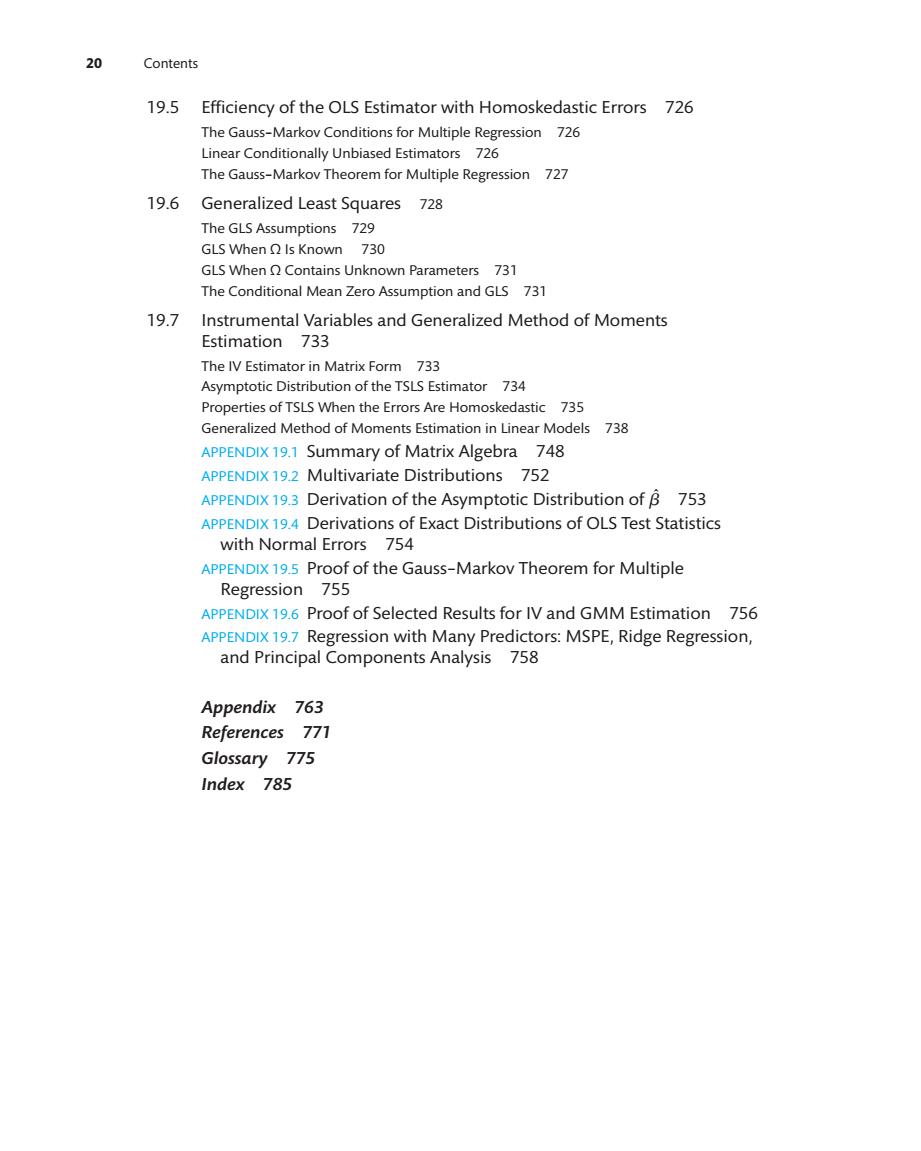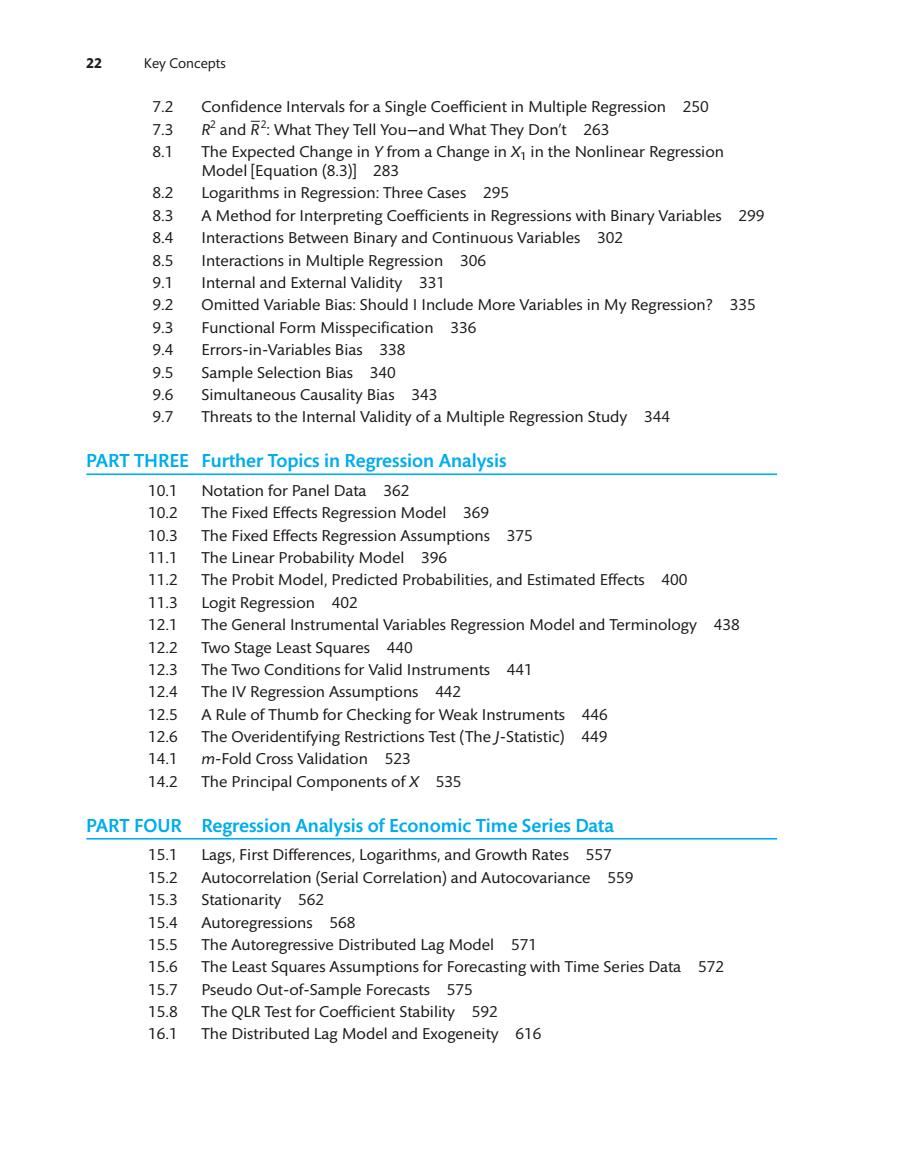
20 Contents 19.5 Efficiency of the OLS Estimator with Homoskedastic Errors 726 The Gauss-Markov Theorem for Multiple Regression 727 19.6 Generalized Least Squares 728 The GLS Assumptions 729 GLS When O Is Known 730 GLS WhenContains Unknown Parameter 731 The Conditional Mean Zero Assumption and GLS 731 19.7 Instrumental Variables and Generalized Method of Moments Estimation 733 The IV Estimator in Matrix Form 733 ropeities of TSLS When the Erorsr Hme 735 the Homoske :735 APPENDIX 19.1 Summary of Matrix Algebra 748 APPENDIX 19.2 Multivariate Distributions 752 APPENDIX 19.3 Derivation of the Asymptotic Distribution of B 753 APPENDIX 19.4 Derivations of Exact Distributions of OLS Test Statistics with Normal Errors 754 APPENDIX 19.5 Proof of the Gauss-Markov Theorem for Multiple Regression 755 APPENDIX 19.6 Proof of Selected Results for IV and GMM Estimation 756 APPENDIX 19.7 Regression with Many Predictors:MSPE,Ridge Regression, and Principal Components Analysis 758 Appendix 763 References 771 Glossary 775 Index 785
19.5 Efficiency of the OLS Estimator with Homoskedastic Errors 726 The Gauss–Markov Conditions for Multiple Regression 726 Linear Conditionally Unbiased Estimators 726 The Gauss–Markov Theorem for Multiple Regression 727 19.6 Generalized Least Squares 728 The GLS Assumptions 729 GLS When Ω Is Known 730 GLS When Ω Contains Unknown Parameters 731 The Conditional Mean Zero Assumption and GLS 731 19.7 Instrumental Variables and Generalized Method of Moments Estimation 733 The IV Estimator in Matrix Form 733 Asymptotic Distribution of the TSLS Estimator 734 Properties of TSLS When the Errors Are Homoskedastic 735 Generalized Method of Moments Estimation in Linear Models 738 APPENDIX 19.1 Summary of Matrix Algebra 748 APPENDIX 19.2 Multivariate Distributions 752 APPENDIX 19.3 Derivation of the Asymptotic Distribution of b n 753 APPENDIX 19.4 Derivations of Exact Distributions of OLS Test Statistics with Normal Errors 754 APPENDIX 19.5 Proof of the Gauss–Markov Theorem for Multiple Regression 755 APPENDIX 19.6 Proof of Selected Results for IV and GMM Estimation 756 APPENDIX 19.7 Regression with Many Predictors: MSPE, Ridge Regression, and Principal Components Analysis 758 Appendix 763 References 771 Glossary 775 Index 785 20 Contents A01_STOC4455_04_GE_FM.indd 20 06/12/18 10:52 AM

Key Concepts PART ONE Introduction and Review 1.7 Cross-Sectional.Time Series,and Panel Data 53 Expected Value and the Mean 60 riance and Standard Deviation Means,Variances,and Covariances of Sums of Random Variables 74 24 Computing Probabilities and Involving Normal Random Variables 76 25 Simple Random Sampling and i.i.d.Random Variables 82 2.6 Convergence in Probability,Consistency,and the Law of Large Numbers 86 2.7 The Central Limit Theorem 89 3 Estimators and Estimates 105 32 Bias,Consistency,and Effici 105 ency Efficiency of:Is BLUE 107 3.4 The Standard Error of Y 113 35 The Terminology of Hypothesis Testing 115 36 Testing the Hypothesis E(Y)=Hyo Against the Alternative E(Y)Hyo 116 3.7 Confidence Intervals for the Population Mean 118 PART TWO Fundamentals of Regression Analysis 4.1 Terminology for the Linear Regression Model with a Single Regressor 146 4.2 The OLS Estimator,Predicted Values,and Residuals 150 4.3 The Least Squares Assumptions for Causal Inference 160 4.4 Large-Sample Distributions of Bo and 162 General Form of the t-Statistic 179 Testing the HypothesisB=B1.o Against the Alternative BBo 181 53 Confidence Interval for B 185 Heteroskedasticity and Homoskedasticity 190 The Gauss-Markov Theorem for B 195 61 Omitted Variable Bias in Regression with a Single Regressor 213 6.2 The Multiple Regression Model 219 6.3 The OLS Est Predicted Values,and Residuals in the Multiple 221 6.4 The Least Squares Assumptions for Causal Inference in the Multiple Regression Model 227 6.5 Large-Sample Distribution of Bo.B.,B.228 Least Sares Assumptions for Causal inference in the Multiple Regression Model with Cor les 233 7.1 Testing the Hypothesis月=BAgainst the Alternative月≠Bo249 21
Key Concepts PART ONE Introduction and Review 1.1 Cross-Sectional, Time Series, and Panel Data 53 2.1 Expected Value and the Mean 60 2.2 Variance and Standard Deviation 61 2.3 Means, Variances, and Covariances of Sums of Random Variables 74 2.4 Computing Probabilities and Involving Normal Random Variables 76 2.5 Simple Random Sampling and i.i.d. Random Variables 82 2.6 Convergence in Probability, Consistency, and the Law of Large Numbers 86 2.7 The Central Limit Theorem 89 3.1 Estimators and Estimates 105 3.2 Bias, Consistency, and Efficiency 105 3.3 Efficiency of Y: Y Is BLUE 107 3.4 The Standard Error of Y 113 3.5 The Terminology of Hypothesis Testing 115 3.6 Testing the Hypothesis E(Y) = μY,0 Against the Alternative E(Y) ≠ μY,0 116 3.7 Confidence Intervals for the Population Mean 118 PART TWO Fundamentals of Regression Analysis 4.1 Terminology for the Linear Regression Model with a Single Regressor 146 4.2 The OLS Estimator, Predicted Values, and Residuals 150 4.3 The Least Squares Assumptions for Causal Inference 160 4.4 Large-Sample Distributions of b n 0 and b n 1 162 5.1 General Form of the t-Statistic 179 5.2 Testing the Hypothesis b1 = b1,0 Against the Alternative b1 ≠ b1,0 181 5.3 Confidence Interval for b1 185 5.4 Heteroskedasticity and Homoskedasticity 190 5.5 The Gauss–Markov Theorem for b n 1 195 6.1 Omitted Variable Bias in Regression with a Single Regressor 213 6.2 The Multiple Regression Model 219 6.3 The OLS Estimators, Predicted Values, and Residuals in the Multiple Regression Model 221 6.4 The Least Squares Assumptions for Causal Inference in the Multiple Regression Model 227 6.5 Large-Sample Distribution of b n 0, b n 1, c, b n k 228 6.6 The Least Squares Assumptions for Causal Inference in the Multiple Regression Model with Control Variables 233 7.1 Testing the Hypothesis bj = bj,0 Against the Alternative bj ≠ bj,0 249 21 A01_STOC4455_04_GE_FM.indd 21 20/12/18 4:25 PM

22 Key Concepts Confidence Intervals for a Single Coefficient in Multiple Regression 250 73 R2and R2:What They Tell You-and What They Don't 263 The Expected Cha ge in Yfrom a Change in X in the Nonlinear Regression Model [Equation(8.3)]283 8.2 Logarithms in Regression:Three Cases 295 8.3 A Method for Interpreting Coefficients in Regressions with Binary Variables 299 84 Interactions Between Binary and Continuous Variables 302 nteractions in Multiple Regression 306 9.1 Internal and External Validity 331 9.2 Omitted Variable Bias:Should I Include More Variables in My Regression?335 9.3 Functional Form Misspecification 336 9.4 Errors-in-Variables Bias 338 9.5 Sample Selection Bias 340 9.6 Simultaneous causality Bias 343 97 Threats to the Internal Vali idity of a Multiple Regression Study 344 PART THREE Further Topics in Regression Analysis 10.1 Notation for Panel Data 362 10.2 The Fixed Effects Regression Model 369 10.3 The Fixed Effects Regression Assumptions 375 11.1 The Linear Probability Model 396 112 The Probit Model,Predicted Probabilities,and Estimated Effects 400 .3 Logit Regression 402 12 The General Instrumental Variables Regression Model and Terminology 438 12.2 Two Stage Least Squares 440 123 The Two Conditions for Valid Instruments 441 12.4 The IV Regression Assumptions 442 12.5 A Rule of Thumb for Checking for Weak Instruments 446 126 The Overidentifying Restrictions Test(The J-Statistic)449 141 m-Fold Cross Validation 523 14.2 The Principal Components of X 535 PART FOUR Regression Analysis of Economic Time Series Data 15.1 Lags.First Differences.Logarithms.and Growth Rates 557 15.2 Autocorrelation(Serial Correlation)and Autocovariance 559 15.3 Stationarity 562 154 Autoregressions 568 155 The Autoregressive Distributed Lag Model 571 15.6 The Least Squares Assumptions for Forecasting with Time Series Data 572 15.1 Pseudo Out-of-Sample Forecasts 575 15.8 The QLR Test for Coefficient Stability 592 16.1 The Distributed Lag Model and Exogeneity 616
22 Key Concepts 7.2 Confidence Intervals for a Single Coefficient in Multiple Regression 250 7.3 R2 and R2 : What They Tell You—and What They Don’t 263 8.1 The Expected Change in Y from a Change in X1 in the Nonlinear Regression Model [Equation (8.3)] 283 8.2 Logarithms in Regression: Three Cases 295 8.3 A Method for Interpreting Coefficients in Regressions with Binary Variables 299 8.4 Interactions Between Binary and Continuous Variables 302 8.5 Interactions in Multiple Regression 306 9.1 Internal and External Validity 331 9.2 Omitted Variable Bias: Should I Include More Variables in My Regression? 335 9.3 Functional Form Misspecification 336 9.4 Errors-in-Variables Bias 338 9.5 Sample Selection Bias 340 9.6 Simultaneous Causality Bias 343 9.7 Threats to the Internal Validity of a Multiple Regression Study 344 PART THREE Further Topics in Regression Analysis 10.1 Notation for Panel Data 362 10.2 The Fixed Effects Regression Model 369 10.3 The Fixed Effects Regression Assumptions 375 11.1 The Linear Probability Model 396 11.2 The Probit Model, Predicted Probabilities, and Estimated Effects 400 11.3 Logit Regression 402 12.1 The General Instrumental Variables Regression Model and Terminology 438 12.2 Two Stage Least Squares 440 12.3 The Two Conditions for Valid Instruments 441 12.4 The IV Regression Assumptions 442 12.5 A Rule of Thumb for Checking for Weak Instruments 446 12.6 The Overidentifying Restrictions Test (The J-Statistic) 449 14.1 m-Fold Cross Validation 523 14.2 The Principal Components of X 535 PART FOUR Regression Analysis of Economic Time Series Data 15.1 Lags, First Differences, Logarithms, and Growth Rates 557 15.2 Autocorrelation (Serial Correlation) and Autocovariance 559 15.3 Stationarity 562 15.4 Autoregressions 568 15.5 The Autoregressive Distributed Lag Model 571 15.6 The Least Squares Assumptions for Forecasting with Time Series Data 572 15.7 Pseudo Out-of-Sample Forecasts 575 15.8 The QLR Test for Coefficient Stability 592 16.1 The Distributed Lag Model and Exogeneity 616 A01_STOC4455_04_GE_FM.indd 22 20/12/18 5:19 PM

Key Concepts 162 The Distributed Lag Model Assumptions 618 16.3 HAC Standard Errors 624 17.1 Vector Autoregressions 650 17.2 Iterated Multi-period Forecasts 656 17.3 Direct Multi-period Forecasts 658 17.4 Orders of Integration,Differencing,and Stationarity 660 17.5 Cointegration 664 PART FIVE Regression Analysis of Economic Time Series Data 18.1 The Extendedeast Squares Assumptions for Regression with a Single egresso 19.1 The Extended Least Squares Assumptions in the Multiple Regression Model 715 19.2 The Multivariate Central Limit Theorem 718 193 Gauss-Markov Theorem for Multiple Regression 727 19.4 The GLS Assumptions 729
Key Concepts 23 16.2 The Distributed Lag Model Assumptions 618 16.3 HAC Standard Errors 624 17.1 Vector Autoregressions 650 17.2 Iterated Multi-period Forecasts 656 17.3 Direct Multi-period Forecasts 658 17.4 Orders of Integration, Differencing, and Stationarity 660 17.5 Cointegration 664 PART FIVE Regression Analysis of Economic Time Series Data 18.1 The Extended Least Squares Assumptions for Regression with a Single Regressor 689 19.1 The Extended Least Squares Assumptions in the Multiple Regression Model 715 19.2 The Multivariate Central Limit Theorem 718 19.3 Gauss–Markov Theorem for Multiple Regression 727 19.4 The GLS Assumptions 729 A01_STOC4455_04_GE_FM.indd 23 06/12/18 10:52 AM

This page intentionally left blank
A01_MISH4182_11_GE_FM.indd 6 10/06/15 11:46 am This page intentionally left blank